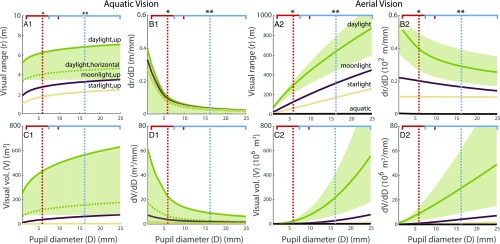Fig. 4.
Visual performance in and out of water. Aquatic vision is estimated using the Baseline River water type defined in SI Appendix, Table S3 at a depth of 8 m. The object is a black 10-cm-diameter disk. (A1 and A2) Maximum distance that the object can be seen in water and air, respectively, under various lighting conditions. Note that visual range scales proportionately to target size. For a 1-cm disk in daylight, the aerial range decreases to 139.3 m assuming mean pupil size for digited tetrapods and 54.7 m for the mean pupil size of finned tetrapods (data not shown). (B1 and B2) How much range is gained for an increase in pupil size? Note that the y-axis multiplier is 100 times larger in B2. (C1 and C2) Total volume within which the standard object is visible. Note that the y-axis multiplier is 1 million times larger in C2. (D1 and D2) How much volume is gained for an increase in pupil size? Note that the y-axis multiplier is 1 million times larger in D2. For the aerial plots, the aquatic values are shown but imperceptible. Uncertainty for the daylight condition (green fill) was calculated by using alternative values for the vision model (Materials and Methods) and is not shown for other conditions for clarity. SD is here only for showing the distribution of estimated pupil sizes; it cannot be used in this context for ascertaining significance because of shared ancestry (details are in the text). *Red horizontal bars show 1 SD of pupil sizes from the mean (dotted vertical lines) estimated for the eye sockets of finned tetrapods. **Blue horizontal bars and vertical lines are for the digited tetrapods.

